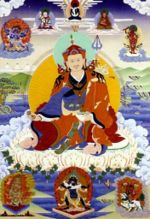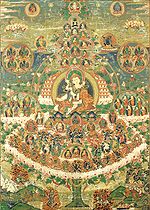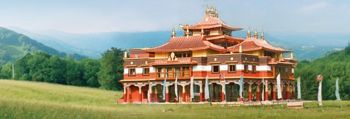Main Page: Difference between revisions
Jump to navigation
Jump to search
m (→Featured Pages) |
|||
| Line 42: | Line 42: | ||
|- | |- | ||
| [[Image:Guru rinpoche.jpg|150px]] || style="background-color:#f7f7f7" cellpadding="5" | | | [[Image:Guru rinpoche.jpg|150px]] || style="background-color:#f7f7f7" cellpadding="5" | | ||
*'''[[Padmasambhava]]''' (Skt.), or '''Padmakara''' (Skt. ''Padmākara''; Tib. ''Pemajungné''; [[Wyl.]] ''pad+ma 'byung gnas'') means ‘Lotus-Born’, which refers to Guru Rinpoche's birth from a lotus in the land of [[Oddiyana]]. '''Guru Rinpoche''', the ‘Precious Master’, is the founder of [[Tibetan Buddhism]] and the [[Buddha]] of our time. Whereas Buddha is known primarily for having taught the teachings of the [[sutra]] vehicle, Padmasambhava came into this world, and to Tibet in particular, in order to teach the [[tantra]]s. While [[Buddha Shakyamuni]] exemplifies the buddha principle, the most important element in the [[sutrayana]] path, Padmasambhava personifies the [[guru]] principle, the heart of [[Vajrayana]] Buddhism, and he is therefore known as the ‘second Buddha’ (Tib. ''sangyé nyipa''). ([[Padmasambhava|Read more...]]) | *'''[[Padmasambhava]]''' (Skt.), or '''Padmakara''' (Skt. ''Padmākara''; Tib. པདྨ་འབྱུང་གནས་, ''Pemajungné''; [[Wyl.]] ''pad+ma 'byung gnas'') means ‘Lotus-Born’, which refers to Guru Rinpoche's birth from a lotus in the land of [[Oddiyana]]. '''Guru Rinpoche''', the ‘Precious Master’, is the founder of [[Tibetan Buddhism]] and the [[Buddha]] of our time. Whereas Buddha is known primarily for having taught the teachings of the [[sutra]] vehicle, Padmasambhava came into this world, and to Tibet in particular, in order to teach the [[tantra]]s. While [[Buddha Shakyamuni]] exemplifies the buddha principle, the most important element in the [[sutrayana]] path, Padmasambhava personifies the [[guru]] principle, the heart of [[Vajrayana]] Buddhism, and he is therefore known as the ‘second Buddha’ (Tib. ''sangyé nyipa''). ([[Padmasambhava|Read more...]]) | ||
|- | |- | ||
|[[Image:LNNRefuge.jpg|150px]] | |[[Image:LNNRefuge.jpg|150px]] | ||
| | | | ||
*'''[[Longchen Nyingtik]]''' ([[Wyl.]] ''klong chen snying thig'') — a [[Nyingma]] cycle of teachings and practice, which was discovered by [[Jikmé Lingpa]] as [[mind terma]]. Regarding the revelation of the Longchen Nyingtik teachings, [[Tulku Thondup]] writes: | *'''[[Longchen Nyingtik]]''' (Tib. ཀློང་ཆེན་སྙིང་ཐིག་, [[Wyl.]] ''klong chen snying thig'') — a [[Nyingma]] cycle of teachings and practice, which was discovered by [[Jikmé Lingpa]] as [[mind terma]]. Regarding the revelation of the Longchen Nyingtik teachings, [[Tulku Thondup]] writes: | ||
:While Guru Rinpoche was visiting Tibet…he conferred the Longchen Nyingtik teachings on [[King Trisong Detsen]], [[Khandro Yeshe Tsogyal]], and [[Vairotsana|Vairochana]]… He gave prophetic [[empowerment]]s by saying that the teachings would be discovered by Jikmé Lingpa, an incarnation (''[[tulku]]'') of King Trisong Detsen. ([[Longchen Nyingtik|Read more...]]) | :While Guru Rinpoche was visiting Tibet…he conferred the Longchen Nyingtik teachings on [[King Trisong Detsen]], [[Khandro Yeshe Tsogyal]], and [[Vairotsana|Vairochana]]… He gave prophetic [[empowerment]]s by saying that the teachings would be discovered by Jikmé Lingpa, an incarnation (''[[tulku]]'') of King Trisong Detsen. ([[Longchen Nyingtik|Read more...]]) | ||
|- | |- | ||
|[[Image:Shantideva.JPG|150px]] | |[[Image:Shantideva.JPG|150px]] | ||
| | | | ||
*'''[[Bodhicharyavatara]]''' (Skt. ''Bodhicaryāvatāra'') or '''Bodhisattvacharyavatara''' (Skt. ''Bodhisattvacaryāvatāra''; [[Wyl.]] ''byang chub sems dpa'i spyod pa la 'jug pa'') or ''Introduction to the [[Bodhisattva]]'s Way of Life'' - [[Shantideva]]'s classic guide to the [[Mahayana]] path. [[Khenpo Namdrol]] said: Concerning the study of the ''Bodhicharyavatara'', my teacher [[Khenpo Tsöndrü]] told me that though the meaning of the text is not difficult to understand, applying the teachings to one’s mind is far more difficult. The purpose of the dharma is to transform the mind, to free us from our attachment to worldly concerns. Among all treatises and texts, Shantideva’s ''Bodhicharyavatara'' and Paltrul Rinpoche’s ''[[Words of My Perfect Teacher]]'' are the most powerful texts that serve this purpose. ([[Bodhicharyavatara|Read more...]]) | *'''[[Bodhicharyavatara]]''' (Skt. ''Bodhicaryāvatāra'') or '''Bodhisattvacharyavatara''' (Skt. ''Bodhisattvacaryāvatāra''; Tib. བྱང་ཆུབ་སེམས་དཔའ་སྤྱོད་པ་ལ་འཇུག་པ་, [[Wyl.]] ''byang chub sems dpa'i spyod pa la 'jug pa'') or ''Introduction to the [[Bodhisattva]]'s Way of Life'' - [[Shantideva]]'s classic guide to the [[Mahayana]] path. [[Khenpo Namdrol]] said: Concerning the study of the ''Bodhicharyavatara'', my teacher [[Khenpo Tsöndrü]] told me that though the meaning of the text is not difficult to understand, applying the teachings to one’s mind is far more difficult. The purpose of the dharma is to transform the mind, to free us from our attachment to worldly concerns. Among all treatises and texts, Shantideva’s ''Bodhicharyavatara'' and Paltrul Rinpoche’s ''[[Words of My Perfect Teacher]]'' are the most powerful texts that serve this purpose. ([[Bodhicharyavatara|Read more...]]) | ||
|} | |} | ||
|width="5%" style="background-color:#ffffff"| | |width="5%" style="background-color:#ffffff"| | ||
Revision as of 21:17, 19 December 2010
|
Welcome to the Rigpa Shedra Wiki,
an online encyclopedia of Tibetan Buddhism
We currently have 11,510 articles
|
|
| Overview · Editing · Search · Policy · Help |
Recent changes · Categories · Site support · Acknowledgements |
Featured Pages
|
Upcoming Events*
Audio LibraryMore teachings... |
Other Rigpa Sites

|

|

|

|

|
| Rigpa.org | Lerab Ling | Dzogchen Beara | Spiritual Care Centre | Tenzin Gyatso Institute |
National Rigpa Centres |
Study & Resources |





